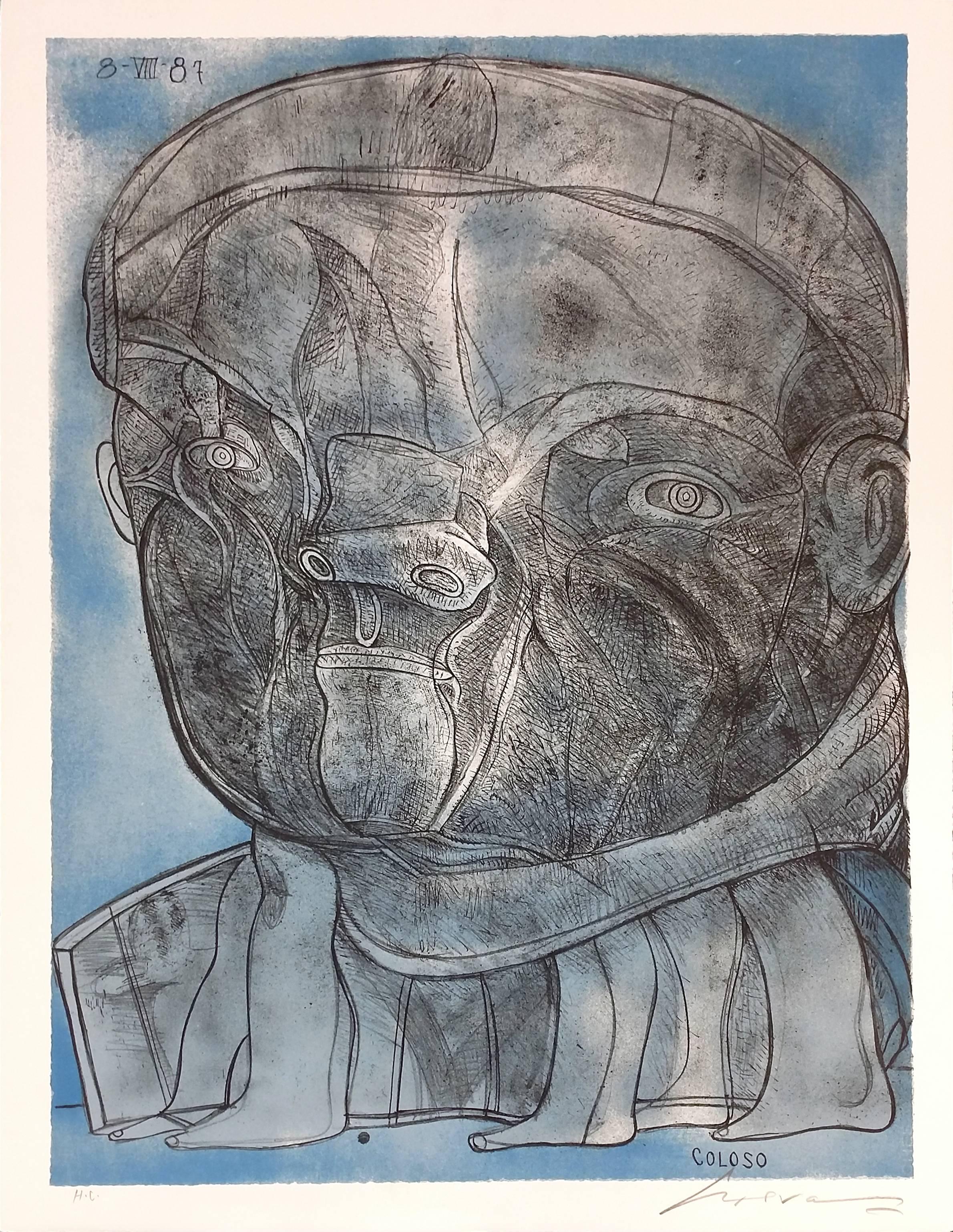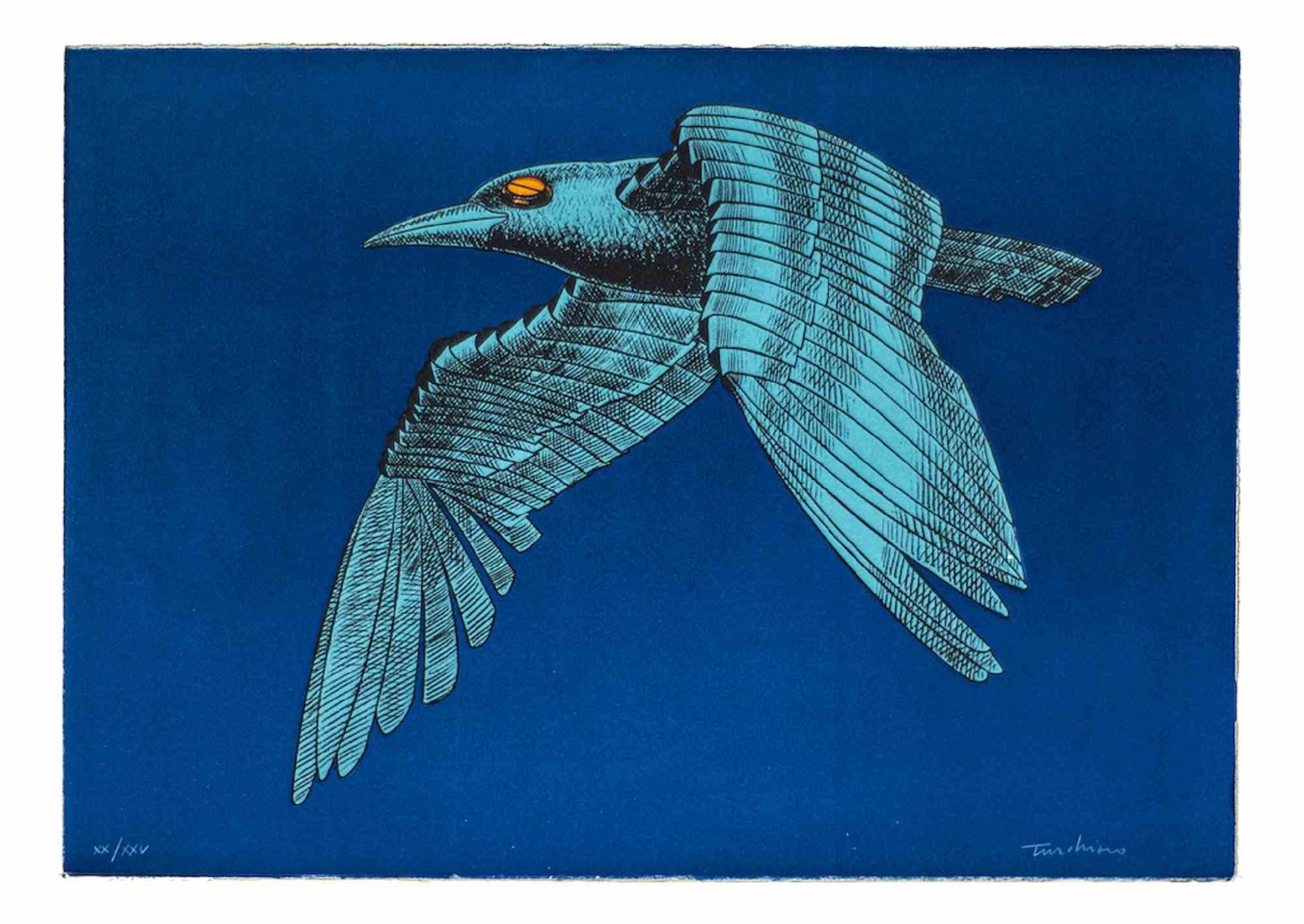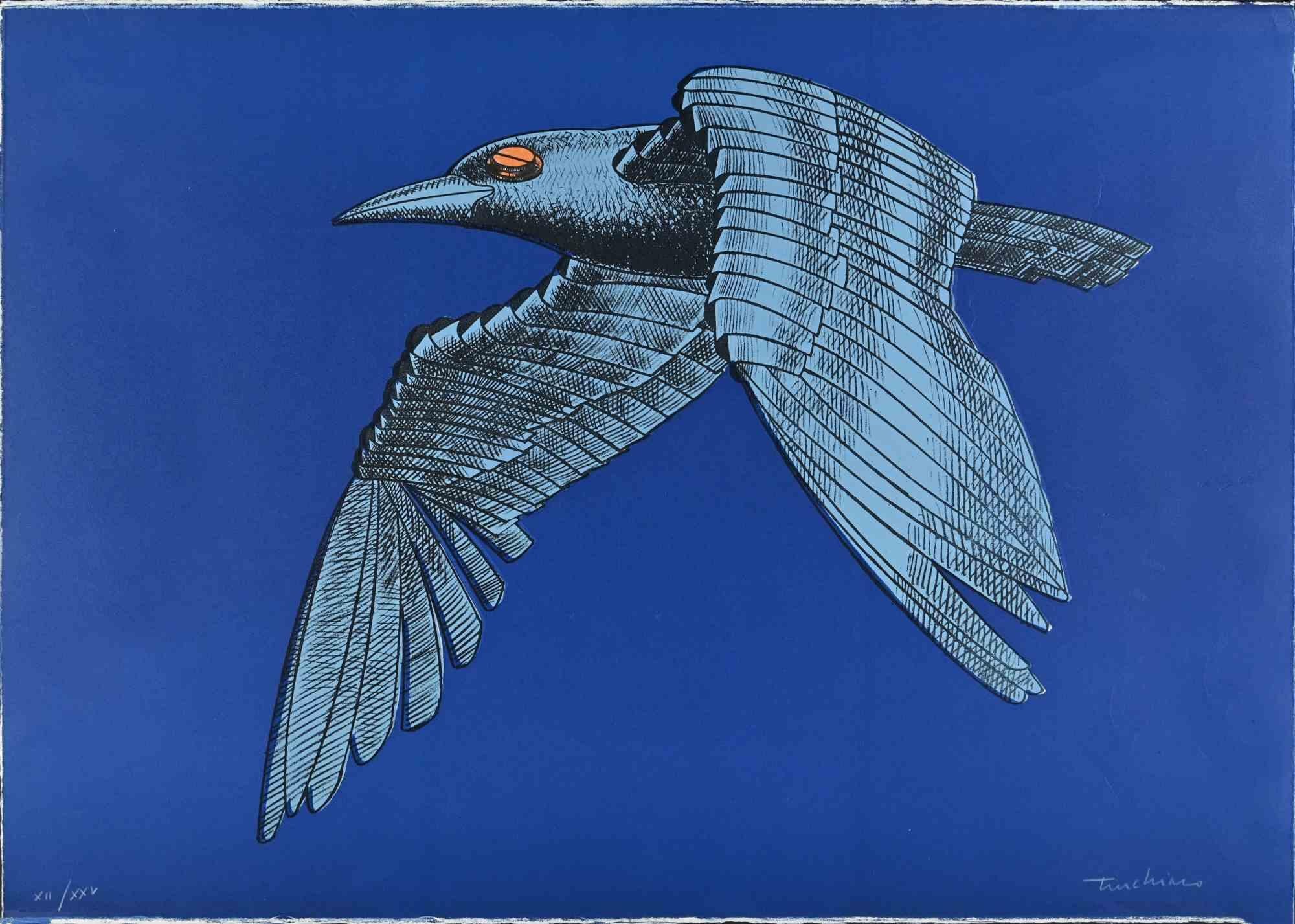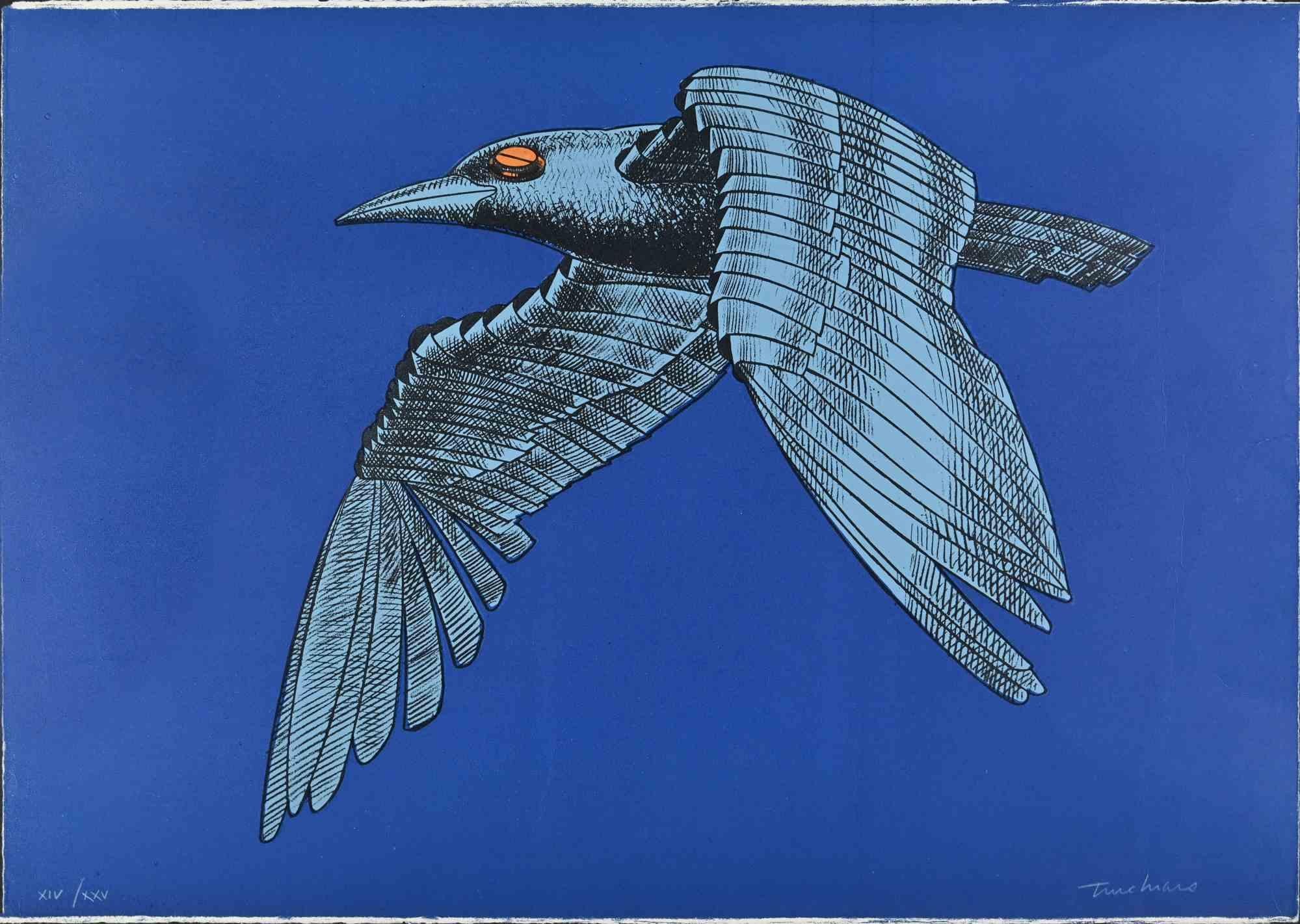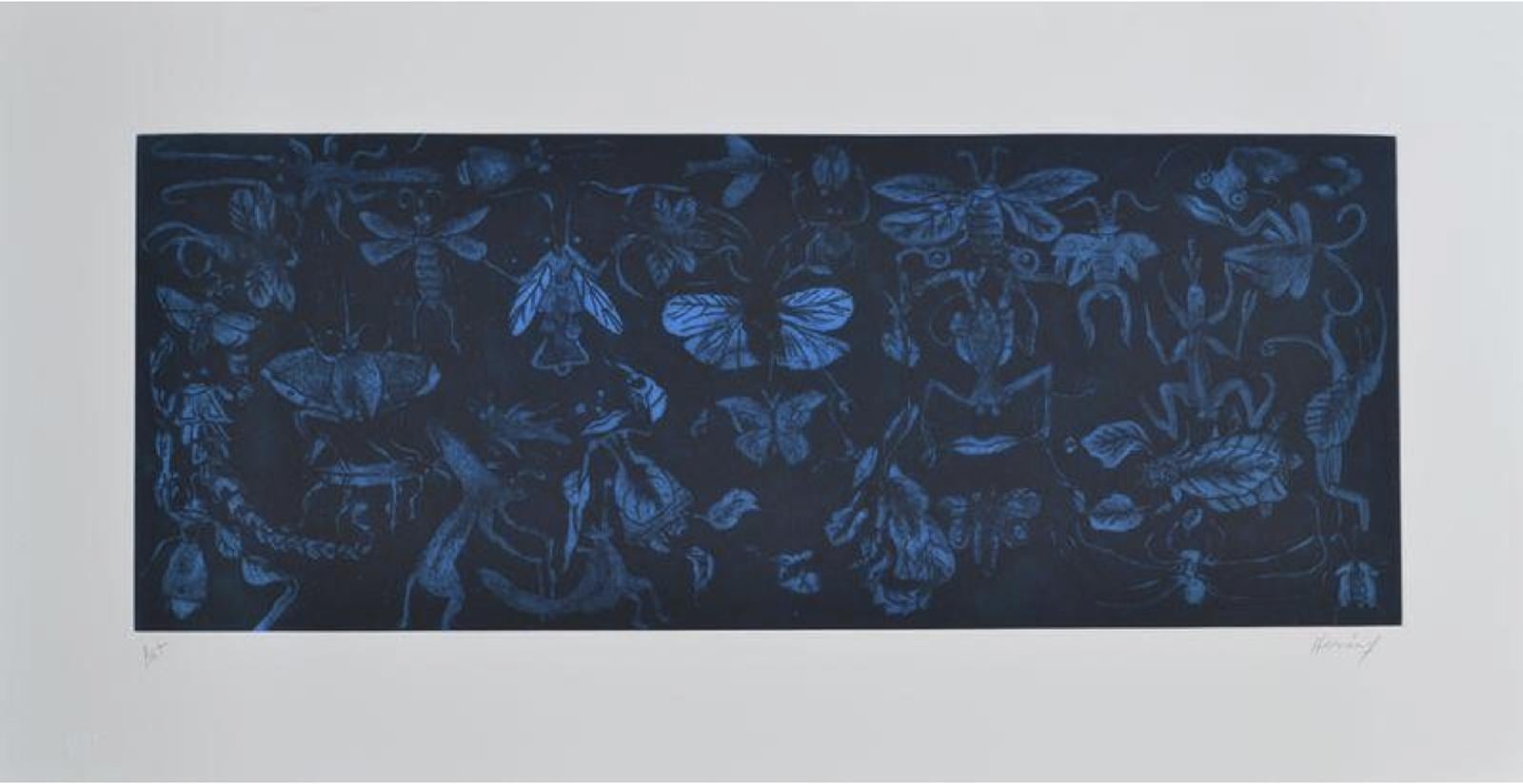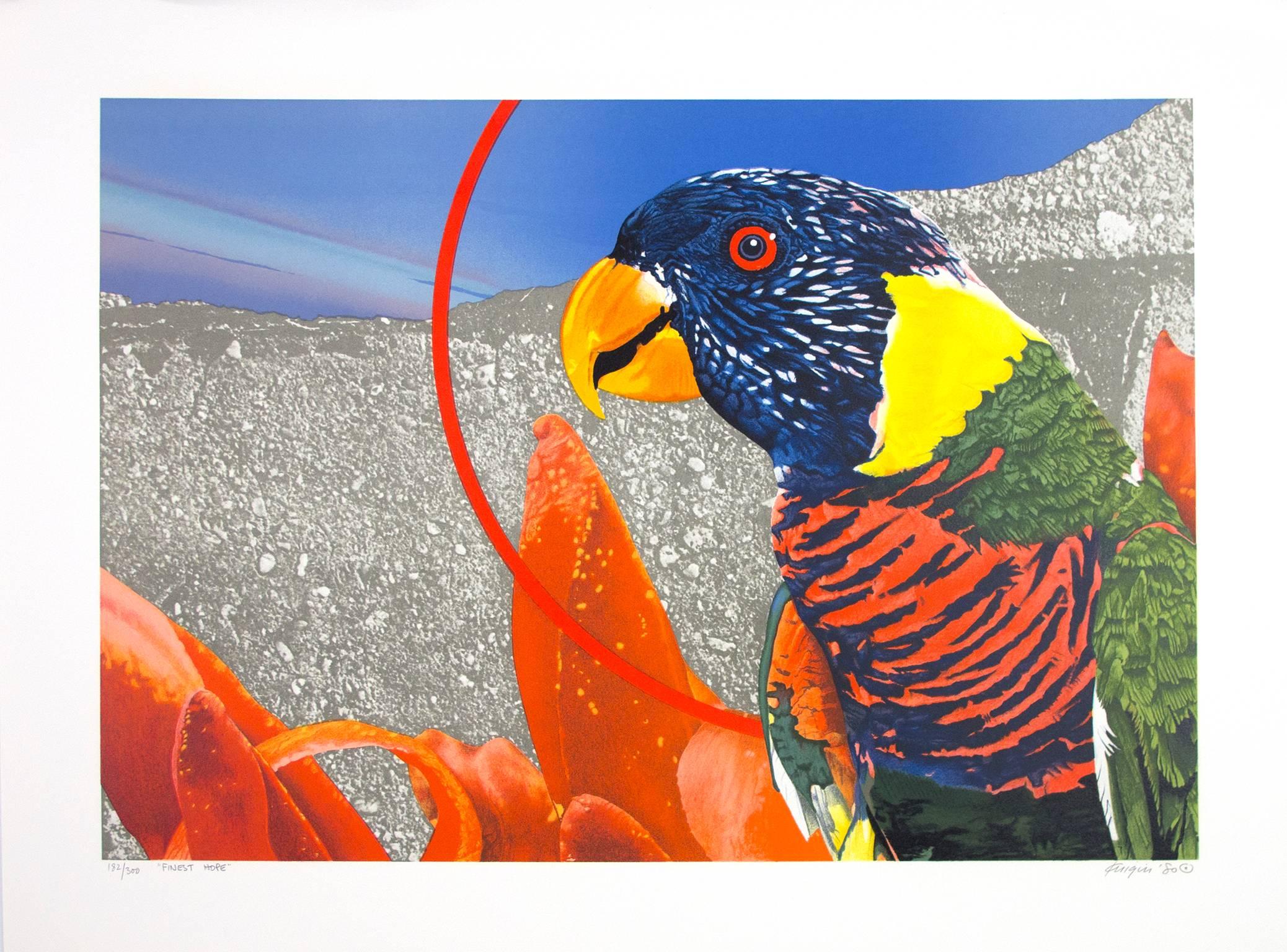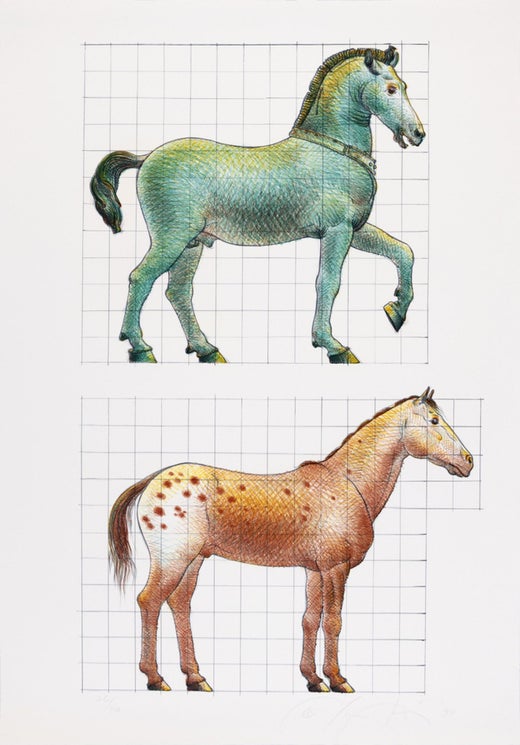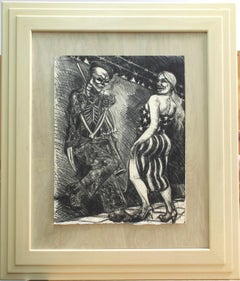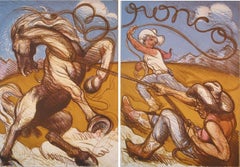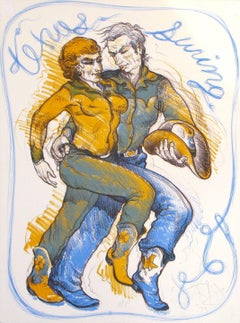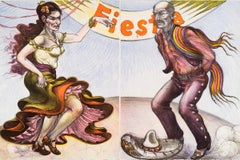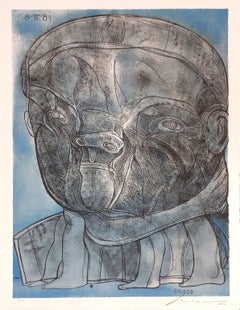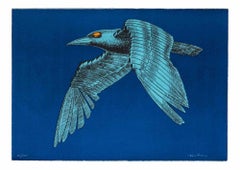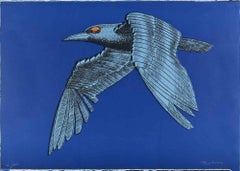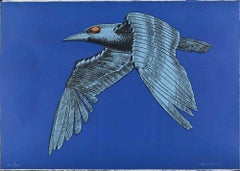Items Similar to Jose by Luis Jimenez
Want more images or videos?
Request additional images or videos from the seller
1 of 5
Luis JiménezJose by Luis Jimenez1986
1986
$12,000
£9,145.94
€10,454.39
CA$16,883.24
A$18,495.07
CHF 9,735.08
MX$220,743.50
NOK 124,097.69
SEK 113,443.99
DKK 78,092.42
About the Item
Jose 1986
Color lithograph 23/30
23 × 34 in 58.4 × 86.4 cm.
SHIPPING CHARGES INCLUDE SHIPPING, PACKAGING & INSURANCE
Luis Jimenez 1940 - 2006
Luis Jiménez was born in El Paso, Texas on July 30, 1940. He is the son of an illegal immigrant who became a citizen at the age of 25. At an early age he worked in his father's neon-sign making shop. As a young person Jiménez witnessed the power of festival music and dance to build community identity, although as a Protestant he was not allowed to dance.After beginning his college education at Texas Western College in El Paso, Jiménez studied architecture at the University of Texas in El Paso and later studied art at the University of Texas in Austin. When he switched his major to fine arts, his father "basically disowned me. He [Jiménez' father] wouldn't speak to me for a couple of years. In 1964 Jiménez studied art in Mexico City, and in 1966 moved to New York City. Jiménez lived in New York City during a time of street riots and anti Vietnam War protests. While living in New York, he worked for the NYC Youth board, worked as a sculptor's apprentice, and succeeded in having his artwork exhibited for the first time. "At his first show, Jiménez received a gold watch from his father. Engraved inside were the conciliatory words, 'To my son the artist.'" The print illustrates the ending of a traditional legend attributed to Aztec culture. Luis Jiménez used the print, as well as numerous drawings, as he worked out his composition for a large fiber glass sculpture also called Southwestern Pieta.
Clearly recognizable subject matter and traditional drawing techniques (anatomical detail and cross hatching, for example) are often characteristics of artworks by Chicano artists. Many Chicano artists also choose ancient Mesoamerican subject matter.
Luis Jiménez work draws from several traditions, from the sign-making practices of his father; from the street culture of the Southwest; from the WPA mural tradition of the Depression; as well as from the graphic traditions of Mexican artists in the first half of the twentieth century. Jiménez went to Mexico City in 1964 to work with Francisco Zúñiga. While there he also saw paintings that he admired by José Clemente Orozco.
"Early on, [Jiménez] realized that the glimmering lowriders cruising the streets and highways of the Southwest had already synthesized painting and sculpture. They were the ultimate accommodation of solidity and translucency, and as a young Protestant, growing up in a Catholic world with an artist's education, Jiménez recognized the traditions of Baroque art in the design and execution of these magical automobiles -- in the way the smooth folds of steel and the hundreds of coats of transparent lacquer caught the light and held it as they slipped through the dry streets like sleeves of liquid color." Dave Hickey, (1997) "Introduction" in Howl: The Artwork of Luis Jiménez by Camille Flores-Turney, New Mexico Magazine, p. 8.
The theme of narrative unites Luis Jiménez' work with many artists of different cultures. Among these artists are Chicana/o artists like, Carmen Lomas Garza, Luis Guerra, and Yolanda López; Mexican artists like Diego Rivera, Frida Kahlo, José Guadalupe Posada, and Alfredo Zalce; American regionalists, such as Thomas Hart , and Grant Wood; and European artists such as Francisco Goya, Honoré Daumier, and William Hogarth.
The idea of seeking cultural identity in legends of the past is a theme that bridges cultures. Examples include the Renaissance revision of classical Greek and Roman art and culture, early U.S. neo-classical architecture, and the Chinese painting tradition of looking to great masters of the past.
The pietà theme, unites Luis Jiménez lithograph with the long tradition of Christian pietas depicting the Virgin Mary holding her dead son, Christ (such as Michelangelo's Vatican pietà).
© 2001 Hispanic Research Center, Arizona State University. Excerpts from Camille Flores-Turney. (1997). Howl: The Artwork of Luis Jiménez
- Creator:Luis Jiménez (1940-2007, American)
- Creation Year:1986
- Dimensions:Height: 23 in (58.42 cm)Width: 34 in (86.36 cm)
- Medium:
- Movement & Style:
- Period:
- Condition:
- Gallery Location:Phoenix, AZ
- Reference Number:1stDibs: LU2623215171332
Luis Jiménez
Born in El Paso, Texas, he worked at his father's neon sign studio as a child, which prepared him to make public art. He studied art and architecture at the University of Texas in Austin and El Paso, earning a bachelor's degree in 1964. He moved to New York City in 1966 after completing his post-graduate work at Ciudad Universitaria, Mexico City, D.F. He became an accomplished artist and taught art at the University of Arizona and later the University of Houston. As a sculptor, Jiménez was known for his large polychromed fiberglass sculptures, often of Southwestern and Hispanic themes. His works were often controversial. They are eminently recognizable due to their themes, his original sculptural style, and the colorful, undulating surfaces the artist employed. The finish of his sculptures had more in common with commercial products than with conventional fine art sculptures. Man on Fire (1969) at the Smithsonian American Art Museum in 2023 Jiménez was influenced by the murals of José Clemente Orozco and Diego Rivera. He was very much a contemporary artist whose roots were in pop art, as much as they were in both the modernism of the Mexican muralists and the regionalism of Thomas Hart Benton and Grant Wood. Heroic sculptures were Jiménez's forte, championing the common man in his work. By working in his father's shop on neon signs and sculptures, he was brought in contact with popular culture, which also included lowrider car culture. The brightly painted fiberglass bodywork, often accented with glitter, served as a particularly relevant artistic influence.[5] While he is best known as a sculptor, Jiménez also made remarkable color lithographs and color drawings in pencil, pastel, and oil stick. He made preparatory drawings for his sculptures, some of which were very large. Most of his sculptures were made of fiberglass, which were cast in a mold, after which they were painted with multiple layers of paint and coated with epoxy. One art expert has noted, "There was no surface on any Luis Jiménez sculpture that was ever any less than six different colors, each airbrushed separately adding a slightly different tone." Jiménez would also often use flake, that glittery quality often seen on lowrider cars, in his paint. In 1993, Jiménez was a recipient of the New Mexico Governor's Awards for Excellence in the Arts. In 1998 he received a Distinguished Alumni award from the University of Texas in recognition of his artwork.
About the Seller
No Reviews Yet
Vetted Professional Seller
Every seller passes strict standards for authenticity and reliability
1stDibs seller since 2023
8 sales on 1stDibs
- ShippingRetrieving quote...Shipping from: Phoenix, AZ
- Return Policy
More From This Seller
View AllCoscolina Con Muerto (Flirt With Death)
Located in Phoenix, AZ
Coscolina Con Muerto (Flirt With Death) 1986
Stone Lithograph Edition 35/50
Size: 26.75 x 21 inches
Frame size: 44.75 x 39
Luis Alfonso Jimenez
Born, 1940, El Paso, Texas, died 2006, Hondo, New Mexico.
Statement: Luis Jimenez, in his work, celebrates the vitality of life. . . . Jimenez es un hijo de la frontera; he knows its people and the landscape. It is the transformation of these people into art that is his most important contribution to the art of this vast region which stretches between Mexico and the United States.
His subject matter utilizes the popular images of the cultura del norte, and a large part of it is depicted and transformed in the rough and tumble world of la frontera. He is also a son of el norte, and so he uses its materials and explores its emerging, popular myths. The tension and attraction of Jimnez’s work is that he always creates within the space of his two worlds, the Mexicano and the Americano. He constantly shows us the irony of the two forces which repel, while showing us glimpses of the synthesis he seeks. What a gift it has been to us for this talented artist to reflect on the soul of our region. He gives meaning to our existence and history.
Rudolfo Anaya (passage chosen by the artist), A View from La Frontera, Man on Fire: Luis Jimnez, pp. 1, 3, 6Biography: Luis Jimnez was born in Texas to parents who had emigrated from Mexico to the United States; he would later dedicate his 1989 sculpture Border Crossing to his father, who had entered the country illegally. The elder Jimnez was a neon sign designer in El Paso, and Luis worked with him as a youth. His experience working in the neon shop and his fascination with U.S. car culture would both become major influences on his art career.
Jimenez studied architecture at the University of Texas, Austin (UTA), and also took art courses in which he first created sculptures with wood, steel, and fiberglass, choosing the latter because of its association with U.S. popular culture. He subsequently became one of the artists who made fiberglass an acceptable medium in the 1960s. In 1964 Jimenez received his B.S. in art from UTA, and he continued his studies at the Universidad Nacional Autnoma de Mexico in Mexico City.
In 1966 he moved to New York City and worked as an assistant to sculptor Seymour Lipton. Jimnez began to exhibit his art while in New York and in 1972 moved to New Mexico to focus on creating public sculptures, even as he maintained his diverse output of drawings, prints, and lithographs.
Drawing on his early experiences, Jimnez creates works that come from a border perspective, one that draws upon the hybridity bred by culture clashes. Often socially and politically informed, his works speak not only in regional terms, those germane to the southwestern...
Category
1980s Contemporary Figurative Prints
Materials
Lithograph
Bronco
Located in Phoenix, AZ
SHIPPING FEES INCLUDE SHIPPING CHARGE, PACKAGING & **INSURANCE**
Luis Alfonso Jimenez
Born, 1940, El Paso, Texas, died 2006, Hondo, New Mexico.
Statement: Luis Jimenez, in his work, celebrates the vitality of life. . . . Jimenez es un hijo de la frontera; he knows its people and the landscape. It is the transformation of these people into art that is his most important contribution to the art of this vast region which stretches between Mexico and the United States.
His subject matter utilizes the popular images of the cultura del norte, and a large part of it is depicted and transformed in the rough and tumble world of la frontera. He is also a son of el norte, and so he uses its materials and explores its emerging, popular myths. The tension and attraction of Jimnez’s work is that he always creates within the space of his two worlds, the Mexicano and the Americano. He constantly shows us the irony of the two forces which repel, while showing us glimpses of the synthesis he seeks. What a gift it has been to us for this talented artist to reflect on the soul of our region. He gives meaning to our existence and history.
Rudolfo Anaya (passage chosen by the artist), A View from La Frontera, Man on Fire: Luis Jimnez, pp. 1, 3, 6Biography: Luis Jimnez was born in Texas to parents who had emigrated from Mexico to the United States; he would later dedicate his 1989 sculpture Border Crossing to his father, who had entered the country illegally. The elder Jimnez was a neon sign designer in El Paso, and Luis worked with him as a youth. His experience working in the neon shop and his fascination with U.S. car culture would both become major influences on his art career.
Jimenez studied architecture at the University of Texas, Austin (UTA), and also took art courses in which he first created sculptures with wood, steel, and fiberglass, choosing the latter because of its association with U.S. popular culture. He subsequently became one of the artists who made fiberglass an acceptable medium in the 1960s. In 1964 Jimenez received his B.S. in art from UTA, and he continued his studies at the Universidad Nacional Autnoma de Mexico in Mexico City.
In 1966 he moved to New York City and worked as an assistant to sculptor Seymour Lipton. Jimnez began to exhibit his art while in New York and in 1972 moved to New Mexico to focus on creating public sculptures, even as he maintained his diverse output of drawings, prints, and lithographs.
Drawing on his early experiences, Jimnez creates works that come from a border perspective, one that draws upon the hybridity bred by culture clashes. Often socially and politically informed, his works speak not only in regional terms, those germane to the southwestern United States, but to broader, more global issues as well. They exhibit a profoundly Chicano aesthetic and sensibility, one that is informed by Mexican and Mexican American traditions, North American popular culture, Chicano cultural icons, and images and themes unique to the Southwest. Death, sexuality, and the struggle of the common people are frequent themes.
Inspired by authors who write in an autobiographical style, Jimnez creates works that function as personal narrative yet are also able to make statements about culture in more global terms. His use of bold colors and lines, a legacy from his fathers work as a neon sign maker, lends a dynamic sensuality to his work, one that is particularly evident in his monumental fiberglass and acrylic urethane sculptural works
Many of Jimnezs works correspond to scholar Toms Ybarra-Fraustos definition of the Chicano aesthetic of rasquachismo, a lowbrow sensibility that appeals to the working class in that it applies to objects that subvert expressions of the mainstream or dominant culture. Creating art that speaks to the people, Jimnez is able to transform regional and culturally specific myths and symbols into globally recognized and relevant icons.
Exhibitions:
In addition to his personal work, Jimnez has been commissioned for numerous public art projects. In 1999 his sculpture Southwest Piet was designated a National Treasure by First Lady Hillary Clinton.
The many exhibitions featuring his work have included Human Concern/Personal Torment (Whitney Museum of American Art, New York, 1969).
The First International Motorcycle Art Show (Phoenix Art Museum, Phoenix, AZ, 1973).
Three Texas Artists (Centre Cultural Americaine, USIS, Paris, 1977),
Recent Trends in Collecting (Smithsonian Institution, Washington, DC, 1982).
Committed to Print (Museum of Modern Art, New York, 1989)
Printmaking in Texas: The 1980s (Modern Art Museum, Fort Worth, TX.
Laguna Gloria Art Museum, Austin, 1990.
The Whitney Biennial (Whitney Museum of American Art, New York, 1991)
Man On Fire: Luis Jimnez (Albuquerque Museum of Art, NM, 1994-95).
47th Annual Purchase Exhibition (American Academy of Arts and Letters, New York, 1995).
Traveling solo exhibition, Working Class Heroes: Images from the Popular Culture (1997-2000).
Jiménez
Collier Gallery has been in continuous operation for over 40 years. Originally located just off Main Street in downtown Scottsdale, Arizona, we have moved to Phoenix to accommodate and showcase our large inventory including:
• Original works by Maynard Dixon, Lon Megargee, Ed Mell, Fritz Scholder, Bill Schenck, Bill Lesch, Luis Jimenez, Greg
Singley, Dan Budnik, and other 20th century Western, WPA and Contemporary Southwestern artists.
• The Fine Art Estate of Lon Megargee
• Vintage rodeo...
Category
1970s Contemporary Figurative Prints
Materials
Lithograph
Texas Swing by Luis Jimenez
By Luis Jiménez
Located in Phoenix, AZ
Texas Swing
Luis Alfonso Jimenez 1940-2006
Stone Lithograph Edition of 50
Artist Proof
24 x 18 inches
Luis Alfonso Jimenez
Born, 1940, El Paso, Texas, died 2006, Hondo, New Mexico.
Statement: Luis Jimenez, in his work, celebrates the vitality of life. . . . Jimenez es un hijo de la frontera; he knows its people and the landscape. It is the transformation of these people into art that is his most important contribution to the art of this vast region which stretches between Mexico and the United States.
His subject matter utilizes the popular images of the cultura del norte, and a large part of it is depicted and transformed in the rough and tumble world of la frontera. He is also a son of el norte, and so he uses its materials and explores its emerging, popular myths. The tension and attraction of Jimnez’s work is that he always creates within the space of his two worlds, the Mexicano and the Americano. He constantly shows us the irony of the two forces which repel, while showing us glimpses of the synthesis he seeks. What a gift it has been to us for this talented artist to reflect on the soul of our region. He gives meaning to our existence and history.
Rudolfo Anaya (passage chosen by the artist), A View from La Frontera, Man on Fire: Luis Jimnez, pp. 1, 3, 6Biography: Luis Jimnez was born in Texas to parents who had emigrated from Mexico to the United States; he would later dedicate his 1989 sculpture Border Crossing to his father, who had entered the country illegally. The elder Jimenez was a neon sign designer in El Paso, and Luis worked with him as a youth. His experience working in the neon shop and his fascination with U.S. car culture would both become major influences on his art career.
Jimenez studied architecture at the University of Texas, Austin (UTA), and also took art courses in which he first created sculptures with wood, steel, and fiberglass, choosing the latter because of its association with U.S. popular culture. He subsequently became one of the artists who made fiberglass an acceptable medium in the 1960s. In 1964 Jimenez received his B.S. in art from UTA, and he continued his studies at the Universidad Nacional Autonoma de Mexico in Mexico City.
In 1966 he moved to New York City and worked as an assistant to sculptor Seymour Lipton. Jimnez began to exhibit his art while in New York and in 1972 moved to New Mexico to focus on creating public sculptures, even as he maintained his diverse output of drawings, prints, and lithographs.
Drawing on his early experiences, Jimenez creates works that come from a border perspective, one that draws upon the hybridity bred by culture clashes. Often socially and politically informed, his works speak not only in regional terms, those germane to the southwestern United States, but to broader, more global issues as well. They exhibit a profoundly Chicano aesthetic and sensibility, one that is informed by Mexican and Mexican American traditions, North American popular culture, Chicano cultural icons, and images and themes unique to the Southwest. Death, sexuality, and the struggle of the common people are frequent themes.
Inspired by authors who write in an autobiographical style, Jimenez creates works that function as personal narrative yet are also able to make statements about culture in more global terms. His use of bold colors and lines, a legacy from his fathers work as a neon sign maker, lends a dynamic sensuality to his work, one that is particularly evident in his monumental fiberglass and acrylic urethane sculptural works
Many of Jimenez's works correspond to scholar Toms Ybarra-Fraustos definition of the Chicano aesthetic of rasquachismo, a lowbrow sensibility that appeals to the working class in that it applies to objects that subvert expressions of the mainstream or dominant culture. Creating art that speaks to the people, Jimenez is able to transform regional and culturally specific myths and symbols into globally recognized and relevant icons.
Exhibitions:
In addition to his personal work, Jimenez has been commissioned for numerous public art projects. In 1999 his sculpture Southwest Piet was designated a National Treasure by First Lady Hillary Clinton.
The many exhibitions featuring his work have included Human Concern/Personal Torment (Whitney Museum of American Art, New York, 1969).
The First International Motorcycle Art Show (Phoenix Art Museum, Phoenix, AZ, 1973).
Three Texas Artists (Centre Cultural Americaine, USIS, Paris, 1977),
Recent Trends in Collecting (Smithsonian Institution, Washington, DC, 1982).
Committed to Print (Museum of Modern Art, New York, 1989)
Printmaking in Texas: The 1980s (Modern Art Museum, Fort Worth, TX.
Laguna Gloria Art Museum, Austin, 1990.
The Whitney Biennial (Whitney Museum of American Art, New York, 1991)
Man On Fire: Luis Jimnez (Albuquerque Museum of Art, NM, 1994-95).
47th Annual Purchase Exhibition (American Academy of Arts and Letters, New York, 1995).
Traveling solo exhibition, Working Class Heroes: Images from the Popular Culture (1997-2000).
Jiménez
Collier Gallery has been in continuous operation for over 40 years. Originally located just off Main Street in downtown Scottsdale, Arizona, we have moved to Phoenix to accommodate and showcase our large inventory including:
• Original works by Maynard Dixon, Lon Megargee, Ed Mell, Fritz Scholder, Bill Schenck, Bill Lesch, Luis Jimenez, Greg
Singley, Dan Budnik, and other 20th century Western, WPA and Contemporary Southwestern artists.
• The Fine Art Estate of Lon Megargee
• Vintage rodeo...
Category
1970s Contemporary Figurative Prints
Materials
Lithograph
Fiesta by Luis Jimenez (Diptych) Stone Lithograph
By Luis Jiménez
Located in Phoenix, AZ
Artist: Luis Jimenez, American (1940 - 2006)
Title: Fiesta (Diptych)
Year: 1986
Medium: Two Lithographs on Arches, signed and numbered in pencil
Edition: 76
Size: 34 x 24 in. (86.36 ...
Category
1980s Contemporary Figurative Prints
Materials
Lithograph
Misfit by Greg Singley
Located in Phoenix, AZ
Title: Misfit
Artist: Greg Singley
Signed original signature
Archival Pigment Print,
100% Rag Paper 300 gm
Paper size: 24 x34 inches
Image Size: 20 x 30 inches
Greg Singley
Greg Singley – was born in 1950 in Greensboro, Alabama. He received his Associates Degree at Walker Collage Jasper Alabama and furthered his college education at the University of South Alabama, Mobile Alabama. He attended the revered Ringling School of Art for his art training in Sarasota Florida and graduated with honors with a certificate in commercial illustration.
In 1978 Singley moved to Phoenix Arizona to pursue his passion for western art and illustration. He worked for several years as an art director for Phoenix Public News and as a freelance illustrator and at the same time experienced sales of Native American and Western Landscape in several Arizona galleries which include Ratliff Williams Gallery, Sedona Arizona, Fagan Peterson Fine Art, Scottsdale and the Dan May Gallery, Scottsdale Arizona.
After a foray into freelance illustration Singley sought representation for his varied abilities and interest in fine art and found the Phoenix Art Group...
Category
2010s Contemporary Figurative Prints
Materials
Archival Pigment
Apache Mountain Spirit Dancer
Located in Phoenix, AZ
SHIPPING CHARGES INCLUDE SHIPPING, PACKAGING & **INSURANCE**
Apache Mountain Spirit Dancer
James Rome
Etching 62/100
Image: 21.75 x 27.5 inches
Paper: 25 x...
Category
1980s Contemporary Figurative Prints
Materials
Etching
You May Also Like
COLOSO
By José Luis Cuevas
Located in Aventura, FL
Hand signed and numbered by the artist. Artwork is in excellent condition. Image size: 32 x 24 inches. Sheet size: 35 x 27. Certificate of Authenticity is included. Of 300. All reas...
Category
1980s Contemporary Portrait Prints
Materials
Paper, Lithograph
$1,750 Sale Price
50% Off
Bird - Lithograph by Aldo Turchiaro - 1980
By Aldo Turchiaro
Located in Roma, IT
Bird is a lithograph by Aldo Turchiaro, realized in 1980.
Hand-signed on the lower right.
Numbered, edition V/XXV.
Good conditions except for aged margins.
The artwork represents...
Category
1980s Contemporary Figurative Prints
Materials
Lithograph
Bird - Lithograph by Aldo Turchiaro - 1980
By Aldo Turchiaro
Located in Roma, IT
Bird is a lithograph by Aldo Turchiaro, realized in 1980.
Hand-signed on the lower right.
Numbered, edition XII/XXV.
Good conditions except for aged margins.
Category
1980s Contemporary Figurative Prints
Materials
Lithograph
Bird - Lithograph by Aldo Turchiaro - 1980
By Aldo Turchiaro
Located in Roma, IT
Bird is a lithograph by Aldo Turchiaro, realized in 1980.
Hand-signed on the lower right.
Numbered, edition XIV/XXV.
Good conditions except for aged margins.
The artwork represen...
Category
1980s Contemporary Figurative Prints
Materials
Lithograph
Sin título
By Sergio Hernández
Located in Cuernavaca, Morelos
Medium: Limited Edition Print.
Paper: Velin Arches 300 g.
Category
2010s Contemporary Figurative Prints
Materials
Etching
"Finest Hope" original lithograph signed pop art abstract hyperrealism collage
By Michael Knigin
Located in Milwaukee, WI
"Finest Hope" is an original color lithograph by Michael Knigin. The artist signed the piece in the lower right and wrote the edition number, 182/300, in the lower left with graphite...
Category
1980s Realist Animal Prints
Materials
Lithograph, Ink
More Ways To Browse
Luis Jimenez
Salvador Dali Elephant
Salvador Dali Signed Prints Elephant
Vintage Beagle Art
African Hunting Art
Andy Warhol Cow Prints
Andy Warhol Cow
Arader Gallery
Audubon Squirrel
Audubon Woodpecker
David Hockney Dog
Hockney Dog
Lee Lozano
Leon Danchin Etching
Leon Spilliaert
Leopard Lithograph
Matthaus Merian
Paintings By Robert Di Giovanni
